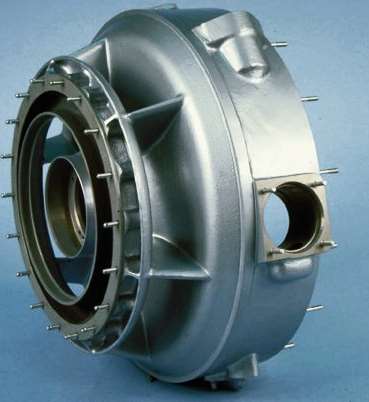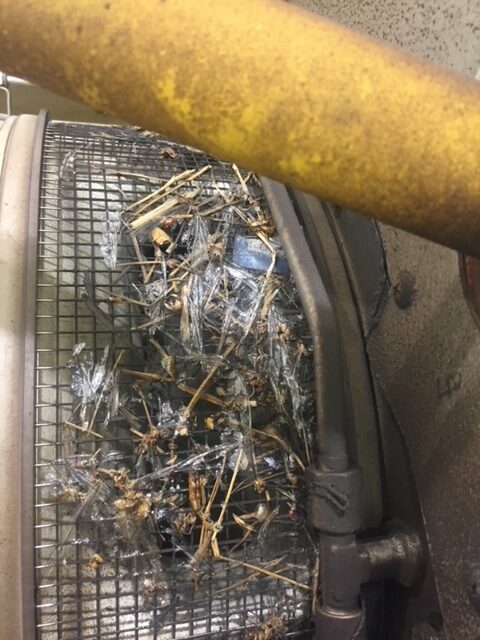I have fielded a few calls over the past couple of weeks about oil coming out of the inlet case after motoring the engine. The presence of oil caused concern for the customers. The best way to show what is going on is to explore the oil tank and what is causing this. We previously discussed the PT6A engine construction and the modular design. We began our look at the engine from the Accessory Gear Box (AGB) at the rear of the engine. The inlet case happens to be the next thing in line.
The inlet case serves several purposes. It directs air into the compressor; in addition, the inlet case is the support for the #1 bearing, which is the thrust bearing for the compressor. It provides placement for the inlet screen, which prevents objects from entering the compressor. It supports the AGB and forms the oil tank. The inlet case is an essential part of the engine design and performs many functions.
When you look at the inlet case shape, imagine the airflow, and you can see the brilliance of the design. The air provided to the engine nacelle is brought in through the ¼” screen and makes a sharp reverse turn. This keeps the compressor rotor from being in line with the flight path and airflow. This allows for a layer of protection after the screen for objects to find their way into the compressor. Gravity will allow the objects to be pulled away from the airflow through the turn. This design also helps reduce the noise of the engine during operation. Not all debris can be stopped by this design. From time to time, we still find FOD (Foreign Object Damage) on the compressor blades. However, much of it is repairable.
When the AGB is installed, the internal cavity formed with the inlet case becomes the oil tank. The bulk of the oil is stored there. The oil begins circulating through the pressure pump in the oil tank into the oil filter housing. The oil goes through the outside of the filter to the inside and is distributed to the engine when the engine is running. Not all the oil is kept in the oil tank. There is some level of oil in the Reduction Gear Box, Fuel to Oil Heater, AGB, and airframe oil cooler. The dipstick is, of course, located on the back of the AGB, but the dipstick is angled and long enough to reach the tank. This is the oil level that one is measuring. Some engine models also have a sight glass to look at the oil level.
The other thing the inlet case does is support the thrust bearing for the compressor. The bearing is inside a housing bolted to the inlet case. There is also an oil jet providing pressure oil direct to the bearing. The design of the PT6 incorporates several air seals, and there is one in this location. The air seal has a rotating and stationary component that provides minimal clearance when the engine operates. Air pressure is found on one side of the seal and oil on the other. That air keeps the oil contained inside the engine.

Now to address the original concern about oil coming out of the inlet case. This typically occurs when the engine has been motored without starting. For instance, when you are performing an engine wash. You motor the engine with the starter (fuel off), so the compressor is spinning, then add soap and/or water to perform the type of wash you are doing. This operation does allow all the systems to begin their normal operation. The pressure oil is sent from the tank to the bearings, so they are lubricated for the engine start. Because the engine is not being started, only rotated, the scavenge pumps cannot move all the oil provided. The #1 bearing cavity floods with oil, and because the engine is not operating, there is no air pressure to keep the oil from bypassing the air seal. This allows oil to come out of the inlet. It also prompts a quick call to your favorite engine guy to ask if it is ok.

What do you do when you see oil out of the inlet? Finish what you are doing (engine wash or whatever caused you to motor the engine). Clean the oil out of the inlet the best you can. If it dripped all over your air filter, you may also want to clean it. The point is to limit the amount of oil ingested by the engine. Oil on the compressor blades attracts chemicals, dirt, dust, and grime. Once everything is clean, start the engine and watch for an oil pressure indication. Run the engine as needed, dry it out after washing and get the oil up to temperature. After shutdown, check the oil within 15 minutes. Adjust the oil level as needed. You won’t need to add unless you were already down a little bit. The tricky thing about turbine oil is that you can spill a teaspoon on the floor, and it will spread out forever and look like you spilled a gallon. Here is where I give my standard warning: don’t overfill the tank. If you do, the engine will push out what it doesn’t want or need.
Here is my best advice. If you have a question or concern, then call and ask someone about it. I always field questions to help folks operate and understand their engines. I would love to help you avoid costly problems and put your mind at rest when something abnormal shows up. I hope everyone is having a great season.
Robert Craymer has worked on PT6A engine and PT6A powered aircraft for the past three decades, including the last 25+ years at Covington Aircraft. As a licensed A&P mechanic, Robert has held every job in an engine overhaul shop and been an instructor of PT6A Maintenance and Familiarization courses for pilots and mechanics. Robert can be reached at robertc@covingtonaircraft.com or 662-910-9899. Visit us at covingtonaircraft.com.





